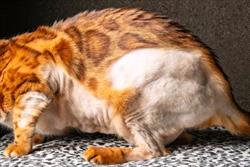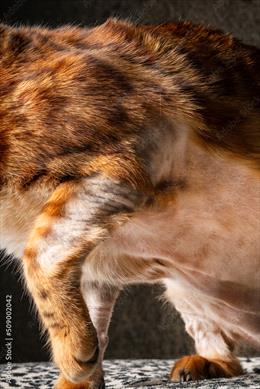Christine D. Calder, DVM, DACVB; VIN Dermatology Consultants
fur mow 1.png

Hair loss patterns like these can be due to behavioral or medical reasons, indicating the need for a comprehensive dermatological workup, as there can be many underlying causes.
In the cat, overgrooming, licking, biting, chewing, and compulsively pulling out hair can lead to hair loss, thin, uneven coats, or baldness. This behavior typically has a medical cause that must be ruled out before a behavioral diagnosis of psychogenic alopecia can be made. Psychogenic means “of the mind”.
Psychogenic alopecia, also known as self-trauma, is a condition in which cats compulsively pull out their hair, leading to thin, uneven coats or baldness. This behavior typically serves as a diagnosis of exclusion, meaning all possible medical reasons must be ruled out before a behavioral diagnosis can be made. Psychogenic means “of the mind”.
A study by Stephen E. Waisglass, et al., published in The Journal of the American Veterinary Medical Association, involving 21 cats suspected of this condition, found that 16 had medical reasons for their behavior, two were purely cases of psychogenic alopecia, and three had medical and behavioral causes. The medical issues primarily included unfavorable reactions to food, allergies, or parasites, with half of the cases having more than one cause.
Causes
When this hair loss due to self-trauma has behavioral causes rather than medical, it is called psychogenic alopecia. Behavioral causes are often linked to environmental stress, frustration, or conflict. Potential triggers for this behavior range from changes in the household environment, including the introduction of new pets or people, to competition for resources in multicat households, lack of hiding spaces, insufficient mental enrichment, and even the sight of neighborhood cats. Although it can also stem from a compulsive disorder, this is relatively rare. Cats in multicat households are particularly prone to displaying this behavior when their basic needs are unmet.
fur mow 2.png

Clinical Signs
Initially, the skin may appear irritated due to pruritus (itch). Itchiness can lead to scratching and licking, chewing, biting, and hair loss, and is the most common symptom of skin disease in cats and dogs. The areas most affected are the flanks (sides). You may not initially notice your cat is overgrooming, as it often occurs only when they are alone or at night; however, the effects on the skin can be seen.
Diagnosis
To diagnose the reason for hair loss in your cat, your veterinarian may start with basic tests, including cytology, to look for infections and skin scrapings to check for mites, followed by fungal cultures and flea medications. They may also conduct blood tests and a urinalysis, along with a thyroid profile, to assess your cat’s overall health. Allergy testing or making a switch to a hypoallergenic diet may be recommended.
If testing does not identify the cause of your cat’s hair loss, glucocorticoids like prednisolone may be prescribed. Diagnosing this condition can be challenging, as both self-inflicted trauma and stress can lead to physical symptoms. However, a primary behavioral cause is more likely if there is a minimal response to treatment with no significant findings from these tests.
Treatment
The treatment plan for this type of hair loss centers around treating the underlying medical conditions present and meeting the basic needs of your cat, which includes environmental modifications.
Known as The 5 Pillars of a Healthy Feline Environment by Sarah Ellis et al., a list of basic needs was published in the Journal of Feline Medicine and Surgery. These include:
- A safe place for rest and/or hiding.
- Multiple and separated resources.
- Opportunities for play and predatory behaviors.
- Positive, consistent, and predictable interactions with humans.
- An environment that respects the cat's sense of smell.
Positive reinforcement training can provide social and mental enrichment, improving communication between you and your cat. It also helps in teaching behaviors that can redirect your cat from overgrooming to different activities, reducing overall stress levels. Punishment, such as yelling, physical punishment, or spraying your cat with water, is never recommended. If specific stressors are found, behavior modification can be employed to help your cat develop positive associations with whatever is causing them distress.
Medical Therapy for Psychogenic Alopecia
Behavioral medications can be helpful in some cases and include:
- Pheromone products help reduce anxiety in some cats. Pheromones are chemicals that cats produce as a means of communication, and the products available for purchase can be used while changing your cat’s environment along with other behavioral therapies. They are available in either a room diffuser or spray.
- Clomipramine (Clomicalm®) is an antidepressant. A low dose may not be sufficient for psychogenic alopecia. Benefits may not be seen for several weeks.
- Fluoxetine (Prozac®) is also an antidepressant. Your veterinarian may recommend starting your cat on a low dose and then increasing it if needed. Benefits may not be seen for several weeks.
- Amitriptyline (Elavil®) is another antidepressant that includes an antihistamine. It does not work well for compulsive disorders but may be helpful to stop itching.
Monitoring and Prognosis for Psychogenic Alopecia
After the self-trauma has stopped and the hair has regrown, you may be able to slowly discontinue behavioral medications while watching your cat to make sure the same behaviors do not start all over again. Be sure to consult with your cat’s veterinarian before discontinuing any medications. Your cat’s long-term prognosis depends on what the underlying cause is for the behavior. Some cats may need medications for a long time, or even for life, while others may not.
With psychogenic alopecia, some cases are easier to treat than others; effective methods may be identified early on, while some behaviors may never completely disappear. Much depends on the extent to which you can address your cat's source of stress and how well secondary skin infections caused by the trauma of overgrooming can be managed.